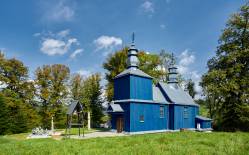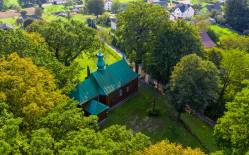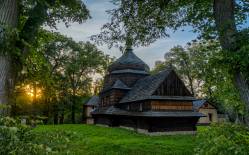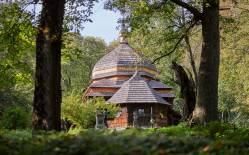The architectural structure of the tserkva in an interesting way combines Latin influences at some point visible in Uniate churches in Galicia with the “Old Ruthenian” style typically used in the late 19th and early 20th century.
The outer body of the structure consists of two parts; however, inside there is a typical three-part layout. The building is covered with a hip roof, and brings to mind wooden Baroque churches. The traditional tripartite structure of the tserkva is also conveyed by three large Baroque-style cupolas with false roof lanterns.
The church was built in 1843 at a location of an older structure. After the forced relocation of the local Greek-Catholic community, the building was taken over for the needs of the Roman Catholics living in the area. Today we can admire the church which was beautifully restored.
The log church, oriented towards the east, inside consist of three parts. The chancel, ending with semi-hexagonal walls, on both sides is adjoined by pastophoria, covered by the same roof. Above the narthex there is a small room. In the nearby village of Lipa we can see a tserkva which, architecturally, is a twin sister of this church.
Inside walls are covered with figural, ornamental and illusionist paintings, suggestive of marble. The polychrome decoration was added in the early 1900s by Kazimierz Szpetkowski and Rudolf Kamieński, artists from Przemyśl. Over the nave we can see barrel vault.
The interior furnishings mainly date from the 1800s. The 19th century iconostasis was dismantled, and its elements adorn the walls. The Apostles, the feasts tier and the Last Supper can be seen in the chancel. There are also two sovereign icons depicting the Mother of God (Hodegetria) and Christ the Teacher, from an older iconostasis. Above the sacrificial table (prestol) with the tabernacle (kivot) there is a sculpted canopy with polychrome decorations.
A wooden belfry stands next to the tserkva. The original brick belfry has not been preserved. It was dismantled in 2006.
Mikołaj Mazurek (1908–2008) was born and died in Brzeżawa. He was a carpenter, sculptor, painter, luthier, musician and poet. His grave can be seen in the cemetery near the tserkva. The artist’s works can be admired in museums in Sanok, Rzeszów and Nowy Sącz.
Photo: Krystian Kłysewicz
Gallery
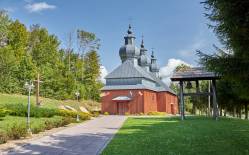
Recommended venues on the Trail



This website has been modernized with the financial support of the European Union under the Cross-Border Cooperation Programme Poland-Belarus-Ukraine 2014-2020. The responsibility for its content lies solely with the Podkarpackie Regional Tourism Board and cannot, in any case, be treated as a reflection of the position of the European Union, the Managing Authority, or the Joint Technical Secretariat of the Cross-Border Cooperation Programme Poland-Belarus-Ukraine 2014-2020.










